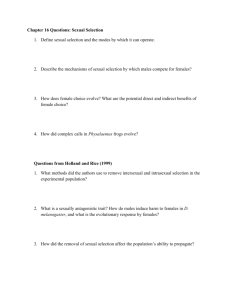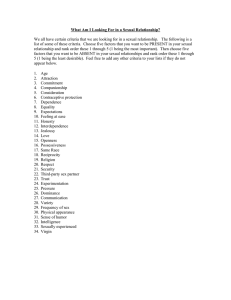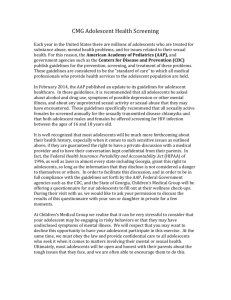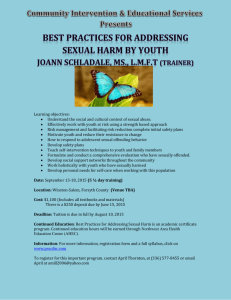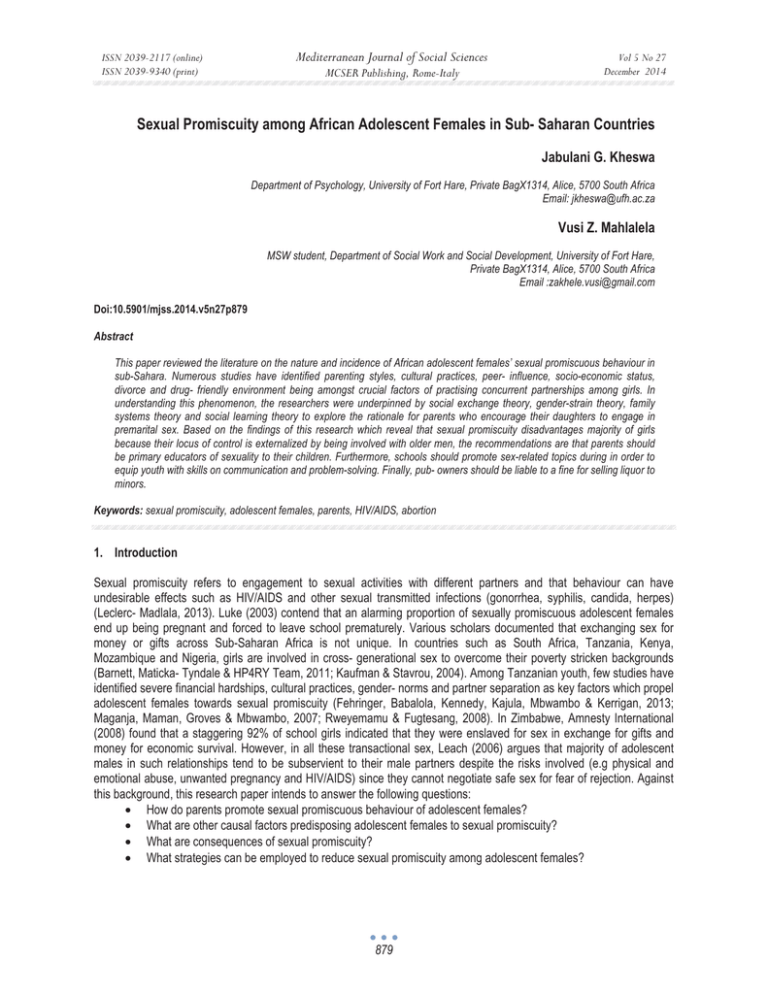
ISSN 2039-2117 (online)
ISSN 2039-9340 (print)
Mediterranean Journal of Social Sciences
MCSER Publishing, Rome-Italy
Vol 5 No 27
December 2014
Sexual Promiscuity among African Adolescent Females in Sub- Saharan Countries
Jabulani G. Kheswa
Department of Psychology, University of Fort Hare, Private BagX1314, Alice, 5700 South Africa
Email: jkheswa@ufh.ac.za
Vusi Z. Mahlalela
MSW student, Department of Social Work and Social Development, University of Fort Hare,
Private BagX1314, Alice, 5700 South Africa
Email :zakhele.vusi@gmail.com
Doi:10.5901/mjss.2014.v5n27p879
Abstract
This paper reviewed the literature on the nature and incidence of African adolescent females’ sexual promiscuous behaviour in
sub-Sahara. Numerous studies have identified parenting styles, cultural practices, peer- influence, socio-economic status,
divorce and drug- friendly environment being amongst crucial factors of practising concurrent partnerships among girls. In
understanding this phenomenon, the researchers were underpinned by social exchange theory, gender-strain theory, family
systems theory and social learning theory to explore the rationale for parents who encourage their daughters to engage in
premarital sex. Based on the findings of this research which reveal that sexual promiscuity disadvantages majority of girls
because their locus of control is externalized by being involved with older men, the recommendations are that parents should
be primary educators of sexuality to their children. Furthermore, schools should promote sex-related topics during in order to
equip youth with skills on communication and problem-solving. Finally, pub- owners should be liable to a fine for selling liquor to
minors.
Keywords: sexual promiscuity, adolescent females, parents, HIV/AIDS, abortion
1. Introduction
Sexual promiscuity refers to engagement to sexual activities with different partners and that behaviour can have
undesirable effects such as HIV/AIDS and other sexual transmitted infections (gonorrhea, syphilis, candida, herpes)
(Leclerc- Madlala, 2013). Luke (2003) contend that an alarming proportion of sexually promiscuous adolescent females
end up being pregnant and forced to leave school prematurely. Various scholars documented that exchanging sex for
money or gifts across Sub-Saharan Africa is not unique. In countries such as South Africa, Tanzania, Kenya,
Mozambique and Nigeria, girls are involved in cross- generational sex to overcome their poverty stricken backgrounds
(Barnett, Maticka- Tyndale & HP4RY Team, 2011; Kaufman & Stavrou, 2004). Among Tanzanian youth, few studies have
identified severe financial hardships, cultural practices, gender- norms and partner separation as key factors which propel
adolescent females towards sexual promiscuity (Fehringer, Babalola, Kennedy, Kajula, Mbwambo & Kerrigan, 2013;
Maganja, Maman, Groves & Mbwambo, 2007; Rweyemamu & Fugtesang, 2008). In Zimbabwe, Amnesty International
(2008) found that a staggering 92% of school girls indicated that they were enslaved for sex in exchange for gifts and
money for economic survival. However, in all these transactional sex, Leach (2006) argues that majority of adolescent
males in such relationships tend to be subservient to their male partners despite the risks involved (e.g physical and
emotional abuse, unwanted pregnancy and HIV/AIDS) since they cannot negotiate safe sex for fear of rejection. Against
this background, this research paper intends to answer the following questions:
• How do parents promote sexual promiscuous behaviour of adolescent females?
• What are other causal factors predisposing adolescent females to sexual promiscuity?
• What are consequences of sexual promiscuity?
• What strategies can be employed to reduce sexual promiscuity among adolescent females?
879
ISSN 2039-2117 (online)
ISSN 2039-9340 (print)
2.
Mediterranean Journal of Social Sciences
MCSER Publishing, Rome-Italy
Vol 5 No 27
December 2014
Methodology
De Vos, Fouche, Strydom and Delport (2011) are of the opinion that reviewing of literature should be aimed at
contributing at a clearer understanding of the nature and meaning of the problem that has been identified. To get rich
information of this research paper, the researchers reviewed the literature studies from academic journals, books and
internet sources.
3.
Parenting Styles and Theories Explaining Sexual Practices by Adolescent Females
A growing body of evidence cites family system as the center of learning. The family system theory suggests that
individuals cannot be understood independently of their family members since families are systems which are
interconnected and interdependent (Gavazzi, 2012). Through family interactions, parents may have influence on child
sexual behaviour and in so doing transmit values, knowledge and attitudes about sex. Of the four parenting styles
pioneered by Diana Baumrind, namely; permissive, authoritative, authoritarian and uninvolved parenting styles, Coulshed
and Orme (2006) found that adolescent females raised in households characterized by uninvolved and permissive
parents, are likely to be involved in concurrent sexual relationships. Permissive parents are characterized by less
demands (Kilmann, Carranza & Vendemia, 2006) and research indicates that their children have difficulties with selfcontrol and demonstrate egocentric tendencies that can interfere with proper development of peer relationships as their
parents tend to be irresponsible in instilling values and morals (Kopko, 2007). Back as far as in 1993, Sharif found that in
Ghana, parents encouraged their daughters into premarital, appreciate to receiving gifts from their daughters’ sexual
partners and see nothing wrong when their daughters exchange sex for money. Consistent with this finding, in the urban,
semi-urban and rural areas of Dar es Salaam, Shinyanga, Iringa and Mbeya, Tanzania, Fehringer and her colleagues
(2012) found that parents were involved in promoting sexual promiscuity among their daughters. Parents were reported to
be silent when their daughters come home with money, food, clothes and other consumer goods, yet knowing that they
were unemployed. In Malawi, the context within which money or resources are exchanged demonstrates the expression
of traditional courting practices and the way love between two people is socially communicated (Poulin, 2007).
Because parents are laissez-faire, this may impact negatively on the cognitive, emotional and empathy
developments of the adolescents which will in turn result in poor academic achievement and school involvement (Aunola,
Stattin & Nurmi, 2000; Carlo, McGinely, Hayes, Batenhot & Wilkinson, 2007). On the other hand, uninvolved parents do
not guide their children nor discipline them. They have “I don’t care attitude” and their adolescent females tend to display
personalities which could be associated with poor educational performance, anti-social behaviour, delinquency, selfconfidence, and maladjustment (Louw & Louw, 2007). In the same view, in a South African study, Holborn and Eddy
(2011) documented that owing to lack of proper guidance non- commitment from African parents or guardians,
adolescent females become pregnant even before they complete their Grade 12.
According to Nicholas (2008), adolescent females may learn behavioral patterns from outside world. During the
transition adolescents are easily influenced through beliefs, attitudes and experiences of people within the environmental
settings (Louw, Van Ede & Louw, 2009). Drawing from Bandura’s social learning theory, through observing and imitating
significant others, adolescent females may find it easy to engage in sexual promiscuity. Through imitation and vicarious
learning, peer influence and the role played by mass- media, could outweigh parental influence especially when parents
are not exemplary in their conduct (Ryckman, 2008; Schultz &Schultz, 2013). For example, when parents are involved in
extramarital affairs, adolescent females’ locus of control tends to be externalized and they are likely to experience
confusion regarding healthy sexual practices (Brooks, 2006). This finding accords with the qualitative study by IRIN
(2014) among adolescent females in Kenya, who left school prematurely to be in multiple sexual relationships with older
men because their own mothers were prostitutes.
The work by Erik Erikson highlights that identity confusion during adolescence is likely to engulf the mind of girls
about the values to uphold to buffer against risk factors (substance abuse, multiple partners and unwanted pregnancy)
when parents do not provide necessary coaching (Bee & Boyd, 2003). Hence they become easily influenced by their
peers to explore unhealthy sexual practices and conform to the expectations of peers, which make them to be drug
abusers and leave school prematurely (Nicholas, 2008).
4.
Factors Influencing Sexual Promiscuity among Adolescent Females in African Countries
There are multiple factors influencing sexual promiscuity among adolescent females, namely; socioeconomic status of
parents, culture, peer influence, mass-media, single parenthood, divorce and drug friendly environment, and their
880
ISSN 2039-2117 (online)
ISSN 2039-9340 (print)
Mediterranean Journal of Social Sciences
MCSER Publishing, Rome-Italy
Vol 5 No 27
December 2014
discussion follows;
4.1
Socioeconomic status of parents
According to Bezuidenhout and Joubert (2008), a family with low socioeconomic status may be characterized by divorce,
violence, and low standard of living and also neglect. Parents who have a low source of income feel very difficult for them
to support the family with the basic needs. To this end, adolescents opt to engage in sexual promiscuity to bridge the
economic gap. Consequently, Benatar (2008) postulate that, risk sexual activity, teenage pregnancy and birth occur at
greater rates among economically disadvantaged teenagers. This author mentioned that, 83% of adolescents who
become pregnant are from homes with economic disadvantage, these adolescence ranges from the age of 15-17.
Furthermore, in a study undertaken by Bradley and Corwyn (2002), distress among poor parents due to their economic
pressure may lead to the overuse of negative control strategies, low warmth and responsiveness, and failure to
adequately monitor children. Thus, adolescents may be exposed to sexual promiscuity because during adolescence
cognitive development is not yet developed.
Although majority of research studies emphasize poverty as the primary factor leading adolescent females to be
promiscuous, Leclerc- Madlala (2013) discovered that even girls from affluent families get involved in intergenerational or
age-desperate relationships ( i.e. romantic relationship between young females and older male partners). For example, a
17 year- old girl, from Gaborone, Botswana, who was involved with a 37 year old was quoted as saying:
“It is all about peer pressure, we compete with the type of cell phone, our hair styles, the type of vehicles our boyfriends
drive and the amount of money they have”
A sharp contrast is brought by Cockcroft et al., (2010) with respect to adolescent females who resist
intergenerational relationships despite their harsh economic circumstances. These authors established that there were
still school-girls in Botswana who had a number of strong attributes such as a sense of self-worth, assertiveness and
ideal-self who reported to have respect for marriage and believed that any older man must be treated as a parent. From
this finding, this could imply that there are adolescent females who are resilient and optimistic in African communities. In
other words, they refute the idea of being degraded, treated as sex objects and always hidden by their partners to avoid
stigma because in Zulu or Xhosa community, when a female is in concurrent relationship with a married man, she is
called “roll-on” or “makhwapheni”. The etymology in English of the term “roll –on” signifies what is used underarm to
refresh in the same way as the deodorant because they are additional partners (Oxlund, 2007). Unlike adolescent
females in Khayelitsha, Cape- Town, who see nothing wrong in concurrent relationships, for as long their basic needs are
met and do not lack transport to go to school, they are comfortable in sharing taxi-drivers (Maughan- Brown, 2012), these
ones are determined and goal- oriented.
4.2
Culture
Across Africa among indigenous communities, it increasingly becomes a norm for people to be involved in concurrent
relationship and justify the practice by referring to culture. This is the practice, desire, or acceptance of having more than
one intimate relationship at a time with the knowledge and consent of everyone involved (Mswela, 2009; Nzegwu, 2009).
But it is important to distinguish polygamy from the traditional forms of non-monogamy. This is because although
polygamy entails a man’s engagement with many females, it is morally, ethically allowed (Jackson, 2002). The causes of
promiscuity may be as a result of the so called ‘open relationship’ which is one of the things considered as human
carelessness. Hence people who identify themselves with polygamy typically reject the view that sexual and relational
exclusivity is necessary for deep, committed, long-term loving relationship (Walker, Graeme & Cornell, 2005). For
example, in Khayelitsha, Cape –Town, Maughan- Brown (2012) found that adolescent females were proud to be involved
with older men because they were told to be better than their sexual partners’ wives.
4.3
Peer influence
Peers have a great potential to influence one’s behavior as they often utilize most of time relating to each other.
Functions that are fulfilled by peer influence as indicated by Stevens and Cloete (2009) provide comradeship; facilitate
knowledge and information about the sex activities and weakening of the emotional bond between child and parents so
as to obey the peer group influence. According to Bezuidenhout et al., (2008) when peers are strongly attached to each
881
ISSN 2039-2117 (online)
ISSN 2039-9340 (print)
Mediterranean Journal of Social Sciences
MCSER Publishing, Rome-Italy
Vol 5 No 27
December 2014
other, they tend to spend long period of time together, exchange the extensive patterns of behaviour, in turn, their
association may lead to sexual promiscuity especially if the adolescent females lack internal locus of control. For
example, in a South African study conducted by Wood, Maforah and Jewkes (2007) it was found that 20% of adolescents
became sexually active due to the influence of peers.
4.4
Single parenthood
According to Bezuidenhout and Joubert (2001), single parenting may take three different forms such as the parent may
be termed as single parent as a result of death, absence of other parent due to the divorce which will be discussed later.
A child who can live the environment may experience the problem in socializing processes, behaviour pattern, and
unhappiness. Also this child may sometimes run away from home to look for love and care. Other single parents become
far from his/her children as a result of some work situations that forced them to live far or come after long hours from
home. Children may think that being involved in sexual promiscuity may fill the gap of his/her parents. Other single
parents may not be able to provide children all the needs they want so children may think of finding other means of
providing themselves which may sometimes be negative. Furthermore, in a study conducted in the Western Cape, South
Africa by Macleod (2001) about the mental health and self-perceptions, it was found that a large number of adolescent
with mental problems are those who came from households led by single-mothers. Most adolescents experienced the
depression of not living with their parents as they have nobody to share their personal experiences. Thus, they may be
exposed to promiscuous behavior.
4.5
Divorce
Divorce can be explained as a marriage breakdown between the wife and husband. Research indicates that, the absence
of one parent in nurturing a child could have negative impact in the psycho-social development of the child. Holborn and
Eddy (2011) cite that the absence of father underpins more sexual activities among female adolescents aged 16 and
below. This provide evidence that adolescents who came from dysfunctional families are likely to initiate sexual practices
at younger age. Perhaps there is an inextricable link between parent’s early marriage complications and multiple sexual
partners among adolescents. To this end, a score of researchers indicate that, the instability of parent’s relationship may
force adolescents out of home to find better place for love and safety. Thus, adolescents may be susceptible to a sexual
promiscuity to secure food security and shelter.
4.6
Drug friendly environment
The theory which explains the relationship between sexual promiscuity and substance abuse is the “Big-Five” model by
Robert McCrae and Paul Costa, which asserts that extraverted adolescent females may seek sensation and external
stimulation from the pubs or taverns to fill the emotional void caused by parental neglect during early years of
development, especially when under the influence of alcohol (Ryckman, 2008). Research evidence holds that the
capacity to give consent becomes low when under the influence of substances, thus, adolescents found themselves in a
trap of sexual promiscuity and drugs until they reach the stage of addiction (L’Engle, Brown & Kenneavy, 2006). Once
addiction to drugs their thinking becomes impaired and loses control to resist sexual advances made by males (Stevens
& Cloete, 2009). Okafor and Duru (2010) are of the view that, the excessive use of drugs is due to the liberty and
independence from dysfunctional schools. For instance, in a study of alcohol use and sexual risk behavior conducted by
Pithey and Parry (2009) it was found that 53.2% of schooling adolescents frequently use alcohol. If damage control is not
done, unwanted pregnancies, rape, STIs and HIV/AIDS will affect adolescent females negatively as compared to males
may take advantage of them especially In rural areas where clinics are not easily accessible to get condoms.
4.7
Mass media
Human behavior is learned observationally through modeling by observing others information serves as a guide for
action. Louw and Louw (2007) postulate that mass media has a strong influence on sexual behaviour of adolescents.
Viewing pornographic material has long-term effects and is powerful in speeding up the level of readiness for sexual
debut as the portrayal of how females engage in intercourse with more than two men simultaneously; do not elicit
negative outcomes (Brown, Keller & Stern, 2009). Thus, media may influence promiscuous behavior as they may wish to
practice all those sexual actions to their partners. In a study conducted by L’Engle et al., (2006) it is revealed that media
882
ISSN 2039-2117 (online)
ISSN 2039-9340 (print)
Mediterranean Journal of Social Sciences
MCSER Publishing, Rome-Italy
Vol 5 No 27
December 2014
have an impact on adolescents and their growing behavior and attitudes towards sex with nearly non-existent promotions
of healthy sexual content and messages. Adolescents may be exposed to programs which portray nudity and substance
abuse, which in turn, would undoubtedly have negative impact on their sexual behaviour. Considering their level of
cognitive development, majority of adolescent males may unconsciously attempt to experiment since adolescence is a
stage of curiosity and heightened sexual awakening. In addition, permissive parenting is more likely to be associated with
such practices as adolescents may have access to pornographic material.
Ryckman (2008) validates Karen Horney’s theory and states that if adolescent females do not experience love,
warmth and nurturance from caregivers/ parents, such lack of secure attachment could serve as a ripe ground for adult
males to lure them through social media since they seek a sense of belonging. They may in turn, develop into what Alfred
Adler calls compliant personality, which is perceived to be the display of a behaviour and attitude associated with getting
along with others, including strangers (Schultz & Schultz, 2013).
5.
5.1
Consequences of Sexual Promiscuity
Teenage pregnancy and abortion
The study on parent marital quality and the parent adolescent relationship, sexual activity among adolescent and youth
have the tendency to engage in risky sexual behaviours (Hair, Moore, Hadley, Kaye, Day & Orthner, 2009). Due to the
findings of the study there are possibilities of teen pregnancy and contraction of transmitted infection. The Statistics South
Africa (2009) exposes adolescents contributing on teenage pregnancy. Adolescents from the age of 15 contribute 1% to
teenage pregnancy, 6% at the age of 16; 22% from the age of 17; 23% at the age of 18 and 48% at the age of 19 years.
It is further reported that at the age of 19, 60.6% of adolescents are sexually active (South Africa Statistics, 2009). Thus
adolescents at the age of 19 years contribute more on the teenage pregnancy. The low quality of parental skills is the
triggering factor of risk sexual behaviour which probably results to a disruptive of individual and the community at large.
Bernstein and Gray (2000) and Pitso (2013) identified factors that contribute to teenage pregnancies among black urban
teenagers as sexual experimentation and involvement at an early age, peer pressure against the maintenance of virginity
for both sexes, lack of supervision when both parents are working or in female headed household and the high level of
unemployment. In addition on the factors mentioned above it is necessary to take a note that children may attempt to help
their mothers in informal sectors to make some money, thus the girls may accept sexual advances from adult men who
had money available for sustenance. This may also be a contributing factor which may result to sexual promiscuity
(Okafor & Duru, 2010).
Adolescent females do not plan for sexual intercourse and easily become pregnant as the result of experiencing
peer pressure. Very often, they become shy to tell their parents about their sexual prowess and perceive themselves as
invincible owing to lack of knowledge pertaining to sexuality (Macleod, 2001; Gautam, 2012). When noticing that they
may be pregnant and unsure of the father of the child, abortion becomes the only alternative to curb conflict in the family.
About 1000 abortions occur every month in South Africa and most of them are from teenagers between 12-18 years of
age. It is further reported that on average, 50 abortions a day are performed at Eastern Cape clinics and many of them
performed on children as young as 12 and some of these children have been raped (Kheswa & Takashana, 2014). In
Tanzania, on a study on abortion, approximately 33.3% of adolescent females receiving termination of pregnancy (TOP)
were impregnated by older men (Mkumbo, 2008).
Subsequent to rape, majority of adolescent females experience sexually transmitted infections (e.g. foul smelling
yellowish pus from vagina), rupture of the hymen, abrasion of the vaginal walls as a result of rough penetration, with the
likelihood of infertility (Banwari, 2011). Furthermore, they may be susceptible to cervical cancer or birth defects during
delivery since their bodies are still not developed to carry the baby for 36 weeks (Weiten, 2011).
5.2
Sexual Transmitted infections and HIV/ AIDS
Adolescents who are involved with multiple sexual relationships are at high risk of being infected with HIV and AIDS.
School teenagers with economic crises are usually counted as infected with HIV and AIDS as they have been pressured
by their socio-economic status to offer sexual services for survival in exchange for school needs. In a study conducted by
Holborn and Edddy (2011) about 62% of adolescents were reported to be practicing unsafe sex and that put them at high
risk to contract STIs as they engage in intercourse with multiple partners. Several studies have demonstrated that men
have a greater degree of bargaining power within sexual relationships characterized by social exchange. In a qualitative
study conducted in Nkonkobe Municipality, Eastern Cape Province, South Africa, Kheswa, Dayi and Gqumani (2014)
883
ISSN 2039-2117 (online)
ISSN 2039-9340 (print)
Mediterranean Journal of Social Sciences
MCSER Publishing, Rome-Italy
Vol 5 No 27
December 2014
found that Xhosa- speaking adolescent males took an advantage of vulnerable girls since they had spent money for
them, hence they bully them and demand “flesh- to- flesh”. Drawing from Gender –Strain theory, men with financial power
over their sexual partners tend to demand sex and base their action on cultural and social constructs on how they should
behave (Ngubane, 2010). This ideology continues to keep women and girls at the receiving end with no say to raise their
dissatisfaction (Baldasare, 2012).
5.3
Commercial sex-work
In Uganda, Gysels, Pool and Nnalusiba (2002) documented an association between sexual promiscuity and commercial
sex- work. These researchers found that majority of adolescent females with multiple sexual partners ended up operating
from taverns, back street bars or as waitresses at the restaurants to sustain their lavish lifestyle. Also, though risky, they
sold sex very cheap to truck-drivers in exchange for money. Similarly, in Swaziland, Tobias (2001) found that commercial
sex-workers in their teen years charged exorbitant price for sex to foreigners for not using condoms. Ross, Crisp,
Mansson and Hawkes (2012) note that prostitution is often embedded within the context of “disadvantage” (e.g injecting
of drugs intravenously, child exploitation, homelessness) and in most cases when reporting rape to the police they suffer
stigma and depersonalization. In Mozambique, Bukali- de Graca (2002) found that quid pro quo (i.e. a sexual relationship
between educators and learners) to be rife as girls would be coerced for getting good grades in exchange for sex. This
practice will be secretly handled and put more pressure on the vulnerable girls when they decide to discontinue the
relationship. Of all these, may this group of vulnerable youth realize that even though they may be using other forms of
contraceptives such as intrauterine device ( plastic device placed in uterine cavity) or implants and injections (e.g. DepoProvera) they would contract HIV/AIDS.
5.4
Psychological effects
Derogatory names such as “isifebe” or “whore” for females in multiple sexual relationships are common in most
communities and tend to have detrimental psychological effects in the sense that such youth may be ostracized and be
physically attacked by their lovers/clients or by community members for destroying marriages. For example, in Nelspruit
Mpumalanga Province, South Africa, Anita Tumelo Loba (commercial sex-worker) from Ga Matole got killed by her client
Mr Paul Andrew Oppperman (aged 25). Mr. Opperman revealed that Anita had requested rough sex and be physically
beaten while having sex. The reason for such maniac state was influenced by ecstasy which forced the perpetrator to
dumb her body in the veld after noticing that she was dead (Sowetan, 13May 2014). From psychopathological
perspective, sexual promiscuous adolescents develop borderline personality disorder. Borderline personality disorder
falls under Axis II of the DSM IV as classified by American Psychological Association(APA) and is characterized by
changing sexual partners within a short period to cover emotional emptiness which could have been caused by lack of
attachment and dysfunctional environment (Comer, 2013).
6.
Way Forward
•
•
•
The parents have the duty of educate their adolescent females about moral conduct irrespective of the socioeconomic status and about the dangers of HIV and AIDS and how to prevent it from being transmitted from
one person to another. In rural areas of the Eastern Cape and Kwa Zulu- Natal, South –Africa, in particular,
sex-trade by minors should be reported to the police as most of the victims resort to human-trafficking, leaving
no trace of their whereabouts.
In Zambia, a school- intervention programme called, CHANGE2, targets primary school learners to address
barriers to safe sexual behaviours (Wood, Silwimba, Mumba, du Plessis, Zulu & Malinda, 2008) and may be
adopted by other African countries to provide confidential sexual and reproductive health services.
Pub-owners must be liable to a fine when found selling and hosting minors in their taverns, as at the pubs sextrade is readily available.
References
Amnesty International. (2008). Safe schools: Every girl’s right. Retrieved from
Aunola, k, Stattin H., & Nurmi J. E., (2000) Parenting styles and adolescents achievement strategies, Journal of Adolescents, Vol 23,
205-222.
884
ISSN 2039-2117 (online)
ISSN 2039-9340 (print)
Mediterranean Journal of Social Sciences
MCSER Publishing, Rome-Italy
Vol 5 No 27
December 2014
Baldasare, A. (2012). Gender-Based Violence: Focus on Africa. SAI-From Vision to Results.
Banwari, M. (2011). Poverty, child sexual abuse and HIV in the Transkei region, South Africa. African Health Sciences, Vol 11 (1), S117S121.
Barnett, J. P., Maticka-Tyndale, E., & Team1, T. H. (2011). The gift of agency: Sexual exchange scripts among Nigerian youth. Journal
of sex research, 48(4), 349-359.
Bee, D., & Boyd, D. (2003). Life-span development: Study edition. (3rd ed.). Allyn & Bacon: Boston.
Benatar S. (2008). From Promiscuous to Prim: Gaining Better Understanding of Adolescent Sexual Risk Taking Using the National
Longitudinal Study of Adolescent Health.
Bernstein & Gray (2000). Social Work in action. (6th ed.). Macmillan Publishers. New York.
Bezuidenhout, C., & Joubert, S. (2008). Child and youth misbehavior in South Africa (2nd edition). Van Schaik Publishers: Pretoria.
Bradley, R. H., & Corwyn, R. F. (2002). Socioeconomic status and child development. Annual review of psychology, 53(1), 371-399.
Brooks, J. E. (2006). Strengthening resilience in children and youths: Maximizing opportunities in the schools. Children and Schools,
28(2), 69–76.
Brown, J. D., Keller, S., & Stern, S. (2009). Sex, sexuality, sexting, and sexed: adolescents and the media. Prevention Researcher,
16(4), 12-16.
Bukali- de Graça, F. L. (2002). HIV/AIDS Prevention and Care in Mozambique, a Socio-Cultural Approach. Literature and Institutional
Assessment, and Case Studies on Manga, Sofala Province and Morrumbala District, Zambézia Province, Maputo.
Maputo.
Campbell, C., Foulis, C. A., Maimane, S., & Sibiya, Z. (2005). The impact of social environments on the effectiveness of youth HIV
prevention: A South African case study. AIDS Care, 17(4), 471-478.
Carlo, G., McGinley M., Hayes R., Batenhorst, C., & Wilkinson, J. (2007). Parenting style or practices, parenting, sympathy and
prosaically behaviors among adolescents. The Journal of Genetic psychology, 108,147-176.
Cockcroft, A., Kunda, J. L., Kgakole, L., Masisi, M., Laetsang, D., Ho-Foster, A., ... & Andersson, N. (2010). Community views of intergenerational sex: Findings from focus groups in Botswana, Namibia and Swaziland. Psychology, health &
medicine, 15(5), 507-514.
Comer, R. J. (2013). Abnormal Psychology. Library of congress: United States of America.
Coulshed, V., & Orme, P., (2006). Practice of social work (3rd ed). Prentice-Hall: Englewood Cliffs
de Vos, A. S., Strydom, H., Fouche,C.D, and Delport, C.S.L (2011). Research at Grass Roots: For the social sciences and human
services professions. (4th ed.) Van Schaik Publishers: Pretoria
Fehringer, J. A., Babalola, S., Kennedy, C. E., Kajula, L. J., Mbwambo, J. K., & Kerrigan, D. (2013). Community perspectives on parental
influence on engagement in multiple concurrent sexual partnerships among youth in Tanzania: Implications for HIV
prevention programming. AIDS care, 25(2), 207-214.
Gautam, S. (2012). Best Practices for Youth-Friendly Sexual and Reproductive Health Services in Schools. Best Practices. Advocates
for Youth.
Gavazzi, S. M. (2012). Family Systems Theory. In Encyclopedia of Adolescence (pp.963-967). Springer: US
Gysels, M., Pool, R., & Nnalusiba, B. (2002). Women who sell sex in a Ugandan trading town: Life histories, survival strategies and risk.
Soc Sci Med, 54:179-192.doi:10.1016/S0277-9536(01)00027-2.
Hair, E. C., Moore, K. A., Hadley, A. M., Kaye, K., Day, R. D., & Orthner, D. K. (2009). Parent marital quality and the parent-adolescent
relationship: Profiles of relationship quality. Marriage & Family Review. National Opinion Research Center: Washington, DC.
Holborn, L., & Eddy, G. (2011). First steps to healing the South African family. Johannesburg: South African Institute of Race Relations.
http: // www.amnesty.org./en /library/ info/ACT77/001/2008.
IRIN. (2014). Focus on vulnerability to HIV/AIDS infection. KENYA: United Nations.
Kaufman, C. E., & Stavrou, S. E. (2004). ‘‘Bus fare please’’: The economies of sex and gifts among young people in urban South Africa.
Culture, Health & Sexuality, 6, 377–391.
Kheswa, J.G., & Takatshana, S. (2014). Exploring the Impact of Abortion among Female Students at a South African University Campus:
A Phenomenological Study. Academic Journal of Interdisciplinary Studies, Vol 3 (1), 111-120.
Kheswa, J.G., Dayi. X., & Gqumani, P. (2014). African Adolescent Males and Rape in the Eastern Cape, South Africa: A Need for
Sexuality Education. Mediterranean Journal of Social Sciences, Vol 5 (10), 541-550.
Kilmann, P. R., Carranza, L. V., & Vendemia, J. (2006). Recollections of parent characteristics and attachment patterns for college
women of intact vs. non-intact families. Journal of adolescence, 29(1), 89-102.
Kopko, K. (2007). Parenting styles and adolescents. Retrieved Nov, 20, 2012.
L’Engle, K. L., Brown, J. D., & Kenneavy, K. (2006). The mass media are an important context for adolescents’ sexual behavior. Journal
of Adolescent Health, 38(3), 186-192.
Leach, F. (2006). Researching gender violence in schools: Methodological and ethical considerations. World Development, 34(6), 11291147.
Leclerc-Madlala, S. (2013). "Why young women in southern Africa are going for riskier older men." Exchange on HIV/AIDS Sexuality and
Gender Vol 4, 5-8.
Louw, D. & Louw, A. (2007).Child and adolescent development. The University of Free State: Bloemfontein.
Louw, D.A., Van Ede, D.M., & Louw A.E. (2009). Human development (2nd edition). Kagiso tertiary: Cape Town.
Luke, N. (2003). “Age and economic asymmetries in the sexual relationships of adolescent girls in sub-Saharan Africa.” Studies in
885
ISSN 2039-2117 (online)
ISSN 2039-9340 (print)
Mediterranean Journal of Social Sciences
MCSER Publishing, Rome-Italy
Vol 5 No 27
December 2014
Family Planning, 34(2): 67-86.
Macleod, C. (2003). Teenage pregnancy and the construction of adolescence scientific literature in South Africa. Rhodes University:
Grahamstown, South Africa.
Maganja, R.K., Maman, S., Groves, A., & Mbwambo, J.K. (2007). Skinning the goat and pulling the load: Transactional sex among youth
in Dar es Salaam, Tanzania. AIDS Care Psychological and Socio- Medical Aspects of HIV/ AIDS, 19(8), 974- 981.
Maughan-Brown, B. 2012. Variation in Concurrent Sexual Partnerships and Sexually Transmitted Diseases among African Men in Cape
Town, South Africa. Sexually Transmitted Diseases, 39(7), 537–542.
Mkumbo, K. A. K. (2008). An exploration of the psychosocial factors affecting the development and delivery of school-based sex and
relationships education in Tanzania. (Doctoral dissertation). University of Southampton: Southampton.
Mswela, M. (2009). Cultural Practices and HIV in South Africa: A Legal Perspective. Potchefstroom Electronic Law Journal, Vol. 12, No.
4
Ngubane, S. J. (2010). Gender roles in the African culture: implications for the spread of HIV/AIDS (MPhil dissertation, Stellenbosch:
University of Stellenbosch).
Nicholas L. (2008), Introduction to psychology, (2nd edition). University of Cape Town: Cape Town.
Nzegwu N., (2009). New African Diaspora Indiana University press. Retrieved from http//www.uwbadgers.com/sports/mfootbl/mtt/nzegwu_louis00.html. Accessed on the 17.09.2012.
Okafor, H. C., & Duru, N. E. (2010). Sexual promiscuity among female undergraduates in tertiary institutions in Imo State: An issue for
healthy living. Edo Journal of Counseling, 3(1), 100-109.
Oxlund, B. (2007). The Right One and the Other Ones: Notions of Love, Sex and Relationships among Students at university of
Limpopo, South Africa. Paper presented at the AEGIS European Conference on African Studies. 11–14 July 2007. African
Studies Centre, Leiden, The Netherlands.
Pithey, A., & Parry, C. (2009). Descriptive systematic review of sub-Saharan African studies on the association between alcohol use and
HIV infection. Journal of Social Aspects of HIV/AIDS, 6(4), 155-169.
Pitso, J.T. (2013). Pregnant Teenagers Readiness For Motherhood: A Quantitative Investigation In Nkonkobe Municipality, Eastern
Cape. [Published M.Soc. Sc Thesis]. University of Fort Hare: Alice.
Poulin, M. 2007. Sex, money and pre-marital partnerships in Southern Africa. Social Science and Medicine 65: 2383–93.
Ross, M. W., Crisp, B. R., Månsson, S. A., & Hawkes, S. (2012). Occupational health and safety among commercial sex workers.
Scandinavian Journal of Work, Environment & Health. Vol 2 (38), 105- 119.
Rweyemamu, D., & Fuglesang, M. (2008). Multiple and concurrent sexual partnerships among youth in Tanzania. Dar es Salaam,
Tanzania: Femina HIP.
Ryckman, R.M. (2008). Theories of Personality. Thomson Wadsworth: Belmont.
Schultz, D.P., & Schultz, S.E. (2013). Theories of Personality. (10th ed.). Wadsworth Cengage Learning: Australia
Sharif, H. (1993). AIDS education efforts begin to address plight of Tanzania youth. AIDS Captions; 1(1):20-21. Sowetan. Rough Sex
killed prostitute.13 May 2014.
Statistics South Africa (StatsSA). Mid-year population estimates, 2009. Available from: http://www.statssa.gov.za/publications/
statsdownload.
Stevens, R., & Cloete, M.G.T. (2009). Introduction to criminology. (6th edition). Oxford University press: Cape Town.
Tobias, B.Q. (2001). A descriptive study of the cultural mores and beliefs toward HIV/AIDS in Swaziland, Southern Africa. Int J Adv
Couns, 23:99-113.
Walker, L., Graeme R., & Cornell N., (2005), Man behaving differently. Juta company LTD: Retrieved from http\\books.google.com ›
Social Science › Customs & Traditions. Accessed on the 17.09.2012.
Weiten, W. (2011). Psychology Themes and variations. Cengage: Australia.
Wood, J., Silwimba, J., Mumba, E., du Plessis, J., Zulu, J., & Malinda, M. (2008). AIDS. XVII International AIDS Conference: Abstract
No. WEPEO- 1.
Wood, K., Maforah, N. F., & Jewkes, R. (2007). Sex, violence and constructions of love among Xhosa adolescents: putting violence on
the sexuality education agenda: CERSA.
886

